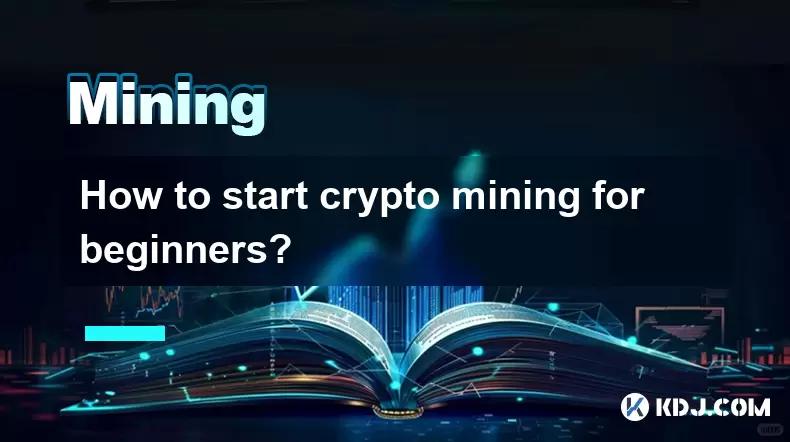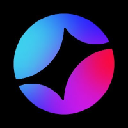-
 bitcoin
bitcoin $114320.977035 USD
-0.40% -
 ethereum
ethereum $4152.439985 USD
-1.75% -
 tether
tether $1.000111 USD
-0.04% -
 xrp
xrp $2.843037 USD
-1.63% -
 bnb
bnb $1013.349380 USD
-1.62% -
 solana
solana $208.362767 USD
-2.10% -
 usd-coin
usd-coin $0.999783 USD
0.00% -
 dogecoin
dogecoin $0.232559 USD
-1.00% -
 tron
tron $0.333491 USD
-1.09% -
 cardano
cardano $0.806310 USD
0.19% -
 hyperliquid
hyperliquid $45.023720 USD
-1.59% -
 ethena-usde
ethena-usde $1.000819 USD
-0.06% -
 chainlink
chainlink $21.241249 USD
-2.11% -
 avalanche
avalanche $30.035416 USD
-0.66% -
 stellar
stellar $0.364984 USD
-2.05%
How to start crypto mining for beginners?
Cryptocurrency mining involves solving complex math problems to validate transactions and earn rewards, but high costs and competition mean it’s not guaranteed profit—research hardware, electricity, and coin choice carefully.
Aug 09, 2025 at 08:07 am

Understanding the Basics of Cryptocurrency Mining
Cryptocurrency mining is the process by which new digital coins are introduced into circulation and transactions are verified on a blockchain network. Miners use powerful computers to solve complex mathematical problems, and the first to solve them gets to add a new block of transactions to the blockchain. In return, they receive a reward in the form of newly minted cryptocurrency. This process is known as proof-of-work (PoW) and is used by networks like Bitcoin and Litecoin. It's essential to understand that mining is not just about earning coins—it's a critical function that maintains the security and integrity of decentralized networks.
Before diving in, beginners must recognize that mining is not a guaranteed profit-making activity. The costs of hardware, electricity, and maintenance can outweigh the rewards, especially for newcomers. Therefore, a solid grasp of how blockchain technology works, the role of miners, and the economic model behind a specific cryptocurrency is crucial. Researching the hash rate, block reward, and difficulty level of a coin helps determine whether mining it is feasible.
Selecting the Right Cryptocurrency to Mine
Not all cryptocurrencies can be mined, and some are more beginner-friendly than others. Coins like Monero (XMR) and Ethereum Classic (ETC) are often recommended for beginners due to lower entry barriers and compatibility with consumer-grade hardware. Ethereum transitioned to proof-of-stake in 2022, so it is no longer mineable, which makes Ethereum Classic a popular alternative for GPU miners.
When choosing a coin, consider the following factors:
- Mining algorithm compatibility: Some coins use RandomX (Monero), which favors CPUs, while others like Zcash use Equihash, suitable for GPUs.
- Network difficulty: High difficulty means more competition and reduced chances of earning rewards.
- Market value and stability: A higher market value might offset lower mining yields.
- Community and development activity: Active communities often mean better support and updated mining tools.
Beginners should start by mining a coin that aligns with their available hardware and energy costs. Joining mining forums or Discord groups can provide real-time insights into which coins are currently profitable and easy to mine.
Choosing and Setting Up Mining Hardware
The type of hardware you use directly impacts your mining efficiency. There are two main types: GPU (Graphics Processing Unit) and ASIC (Application-Specific Integrated Circuit) miners.
- GPU mining is ideal for beginners. Graphics cards from NVIDIA (e.g., RTX 3060 Ti) or AMD (e.g., RX 6700 XT) can mine various coins like Ethereum Classic, Ravencoin, or Monero. GPUs are versatile and can be resold or repurposed for gaming.
- ASIC mining is more powerful and efficient but is expensive and designed for specific algorithms. For example, Bitmain Antminer S19 is built for Bitcoin’s SHA-256 algorithm. These devices are not beginner-friendly due to high upfront costs and noise/heat output.
To set up a mining rig:
- Assemble a motherboard, power supply, RAM, and multiple GPUs on a mining frame.
- Install a lightweight operating system like HiveOS or RaveOS, which are optimized for mining.
- Connect the rig to a stable internet connection and ensure proper ventilation to prevent overheating.
- Update GPU drivers and configure BIOS settings for optimal power efficiency.
Joining a Mining Pool and Configuring Software
Solo mining is rarely profitable for individuals due to high network difficulty. Instead, most beginners join mining pools, where multiple miners combine their computing power to increase the chances of solving a block. Rewards are then distributed based on contributed hash power.
Popular mining pools include:
- F2Pool – Supports multiple coins and has a user-friendly interface.
- Nanopool – Known for low payout thresholds and real-time statistics.
- Poolin – Offers reliable payouts and detailed dashboard analytics.
After selecting a pool, download compatible mining software:
- For GPU mining: PhoenixMiner (for Ethereum Classic), XMRig (for Monero).
- For ASIC devices: Firmware is usually pre-installed, but configuration is done via web interface.
Configuration steps:
- Create an account on the mining pool website and obtain a wallet address.
- Set up a worker name and password in the mining software.
- Enter the pool server address, port, wallet address, and worker credentials in the miner configuration file.
- Launch the software and monitor hash rate, temperature, and accepted shares in the pool dashboard.
Ensure your firewall allows outbound connections on the mining port and that your internet connection remains stable.
Managing Electricity Costs and Monitoring Performance
Electricity consumption is the largest ongoing cost in mining. To avoid losses, calculate your power usage (in watts) and multiply it by your local electricity rate (per kWh) and the number of hours mined. For example, a rig consuming 800W running 24/7 at $0.12/kWh costs about $2.30 per day in electricity.
Use tools like WhatToMine.com to estimate profitability. Input your hardware specs, power cost, and pool fees to see projected daily earnings. Compare this with your electricity cost to determine net gain or loss.
Monitor performance using:
- HiveOS dashboard – Tracks temperature, fan speed, and uptime.
- Minerstat – Provides remote monitoring and alerts.
- Pool statistics page – Shows accepted/rejected shares and estimated payouts.
Adjust settings like core clock, memory clock, and voltage to optimize performance while minimizing power draw. Overclocking can increase hash rate but may reduce hardware lifespan if not done carefully.
Securing Your Earnings and Withdrawing Rewards
Once mining begins, rewards accumulate in your mining pool account. Most pools have a minimum payout threshold, such as 0.1 ETC or 0.1 XMR. After reaching this, the pool automatically sends coins to your specified wallet.
To secure your earnings:
- Use a non-custodial wallet like Monero GUI Wallet, Trust Wallet, or Ledger Nano X.
- Never store coins on exchanges long-term.
- Enable two-factor authentication (2FA) on your pool account.
- Regularly back up wallet seed phrases in a secure, offline location.
Withdrawals are typically processed within 24 hours. Check transaction hashes on a blockchain explorer to confirm receipt. Keep records of all transactions for tax or audit purposes.
Frequently Asked Questions
Can I mine cryptocurrency using my regular laptop?While technically possible, laptop mining is highly inefficient and not recommended. Laptops lack the cooling and power delivery needed for sustained mining, which can lead to overheating and hardware damage. Mining on a laptop rarely generates enough revenue to offset performance degradation and electricity costs.
What happens if my mining rig shuts down unexpectedly?Sudden shutdowns can result from overheating, power supply failure, or software crashes. To prevent this, ensure proper airflow, use a high-quality PSU, and configure automatic restart scripts in your mining OS. Most pools will temporarily pause your contribution but resume once the rig reconnects.
Do I need to pay taxes on mined cryptocurrency?Yes, in most jurisdictions, mined cryptocurrency is considered taxable income at the time it is received. The fair market value in your local currency on the day of mining must be reported. Keep detailed logs of each payout for compliance.
Is cloud mining a good alternative for beginners?Cloud mining allows users to rent hash power from data centers without managing hardware. However, many cloud mining services are scams or unprofitable due to hidden fees and unrealistic promises. Thorough research and reviews are essential before investing.
Disclaimer:info@kdj.com
The information provided is not trading advice. kdj.com does not assume any responsibility for any investments made based on the information provided in this article. Cryptocurrencies are highly volatile and it is highly recommended that you invest with caution after thorough research!
If you believe that the content used on this website infringes your copyright, please contact us immediately (info@kdj.com) and we will delete it promptly.
- BlockDAG, DOGE, HYPE Sponsorship: Crypto Trends Shaping 2025
- 2025-10-01 00:25:13
- Deutsche Börse and Circle: A StableCoin Adoption Powerhouse in Europe
- 2025-10-01 00:25:13
- BlockDAG's Presale Buzz: Is It the Crypto to Watch in October 2025?
- 2025-10-01 00:30:13
- Bitcoin, Crypto, and IQ: When Genius Meets Digital Gold?
- 2025-10-01 00:30:13
- Stablecoins, American Innovation, and Wallet Tokens: The Next Frontier
- 2025-10-01 00:35:12
- NBU, Coins, and Crypto in Ukraine: A New Yorker's Take
- 2025-10-01 00:45:14
Related knowledge

The difference between staking and mining
Sep 24,2025 at 05:18am
Understanding Staking in the Cryptocurrency Ecosystem1. Staking involves holding funds in a cryptocurrency wallet to support the operations of a block...

How to participate in testnet mining?
Sep 22,2025 at 09:18am
Understanding Testnet Mining in the Crypto Ecosystem1. Testnet mining is a method used by blockchain developers to simulate real-world conditions on a...

How to dispose of abandoned mining machines?
Sep 19,2025 at 08:19pm
Assessing the Condition of Abandoned Mining Rigs1. Begin by inspecting each mining machine for visible damage, corrosion, or missing components. Machi...

How to identify high-quality mining pools?
Sep 21,2025 at 03:19pm
Reputation and Track Record1. A mining pool’s reputation is built over time through consistent performance and transparency. Pools that have operated ...

Advantages of decentralized mining pools
Sep 20,2025 at 04:36pm
Enhanced Security and Resistance to Censorship1. Decentralized mining pools operate on blockchain-based smart contracts, eliminating the need for a ce...

What is mining machine overclocking?
Sep 21,2025 at 07:19pm
Understanding Mining Machine Overclocking1. Mining machine overclocking refers to the process of increasing the operating frequency of a cryptocurrenc...

The difference between staking and mining
Sep 24,2025 at 05:18am
Understanding Staking in the Cryptocurrency Ecosystem1. Staking involves holding funds in a cryptocurrency wallet to support the operations of a block...

How to participate in testnet mining?
Sep 22,2025 at 09:18am
Understanding Testnet Mining in the Crypto Ecosystem1. Testnet mining is a method used by blockchain developers to simulate real-world conditions on a...

How to dispose of abandoned mining machines?
Sep 19,2025 at 08:19pm
Assessing the Condition of Abandoned Mining Rigs1. Begin by inspecting each mining machine for visible damage, corrosion, or missing components. Machi...

How to identify high-quality mining pools?
Sep 21,2025 at 03:19pm
Reputation and Track Record1. A mining pool’s reputation is built over time through consistent performance and transparency. Pools that have operated ...

Advantages of decentralized mining pools
Sep 20,2025 at 04:36pm
Enhanced Security and Resistance to Censorship1. Decentralized mining pools operate on blockchain-based smart contracts, eliminating the need for a ce...

What is mining machine overclocking?
Sep 21,2025 at 07:19pm
Understanding Mining Machine Overclocking1. Mining machine overclocking refers to the process of increasing the operating frequency of a cryptocurrenc...
See all articles










































































